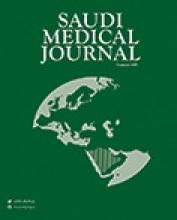Abstract
OBJECTIVE: To identify the characteristics, treatments and hospital outcomes for patients diagnosed with acute coronary syndromes (ACS) in the Gulf area.
METHODS: Prospective, multinational, multicentre, observational survey of consecutive ACS patients who were admitted to 65 hospitals during May 2006.
RESULTS: A total of 1484 ACS patients were recruited. The mean age was 55 years, and 76% were men. The final discharge diagnosis was ST-segment elevation myocardial infarction (STEMI) in 37%, non-ST-segment elevation myocardial infarction (NSTEMI) in 32%, left bundle branch block myocardial infarction (LBBB MI) in 2%, and unstable angina in 29%. Among patients with STEMI and LBBB MI, the reperfusion rate was 65%, with use of primary percutaneous coronary intervention in 7% and thrombolytic therapy in 93%. When thrombolytic therapy was used, the median door to needle time was 45 minutes, with 37% receiving it within 30 minutes of hospital presentation. During the first day of hospitalization, aspirin was administered to 94%, clopidogrel to 51%, and beta blockers to 65%. Angiotensin converting enzyme inhibitors/Angiotensin receptor blockers and statins were used in 62% and 82%, respectively. Coronary angiography during hospitalization was performed in 21%. In-hospital mortality was 3%.
CONCLUSION: We were able to determine the characteristics, treatments and in-hospital outcomes of patients hospitalized with ACS in our region. There is room for improvement in using medications, reducing needle to door time and utilizing more cardiac catheterization services.
- Copyright: © Saudi Medical Journal
This is an open-access article distributed under the terms of the Creative Commons Attribution-Noncommercial-Share Alike 3.0 Unported, which permits unrestricted use, distribution, and reproduction in any medium, provided the original work is properly cited.






